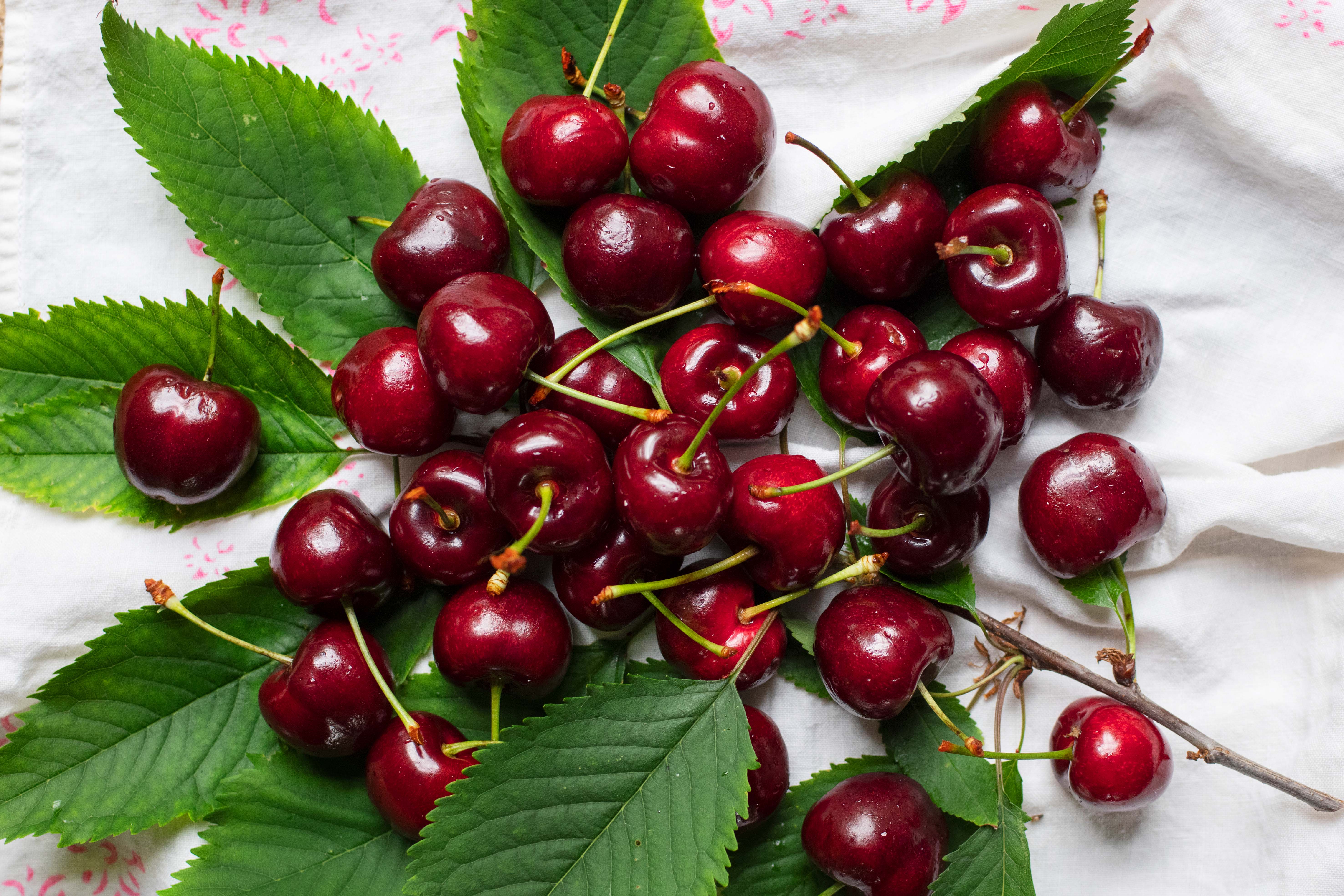
Scoff them straight from the bag, or take the time for a sweet cherry focaccia
Photography by Jonathan Lovekin
Cherries are fruits to eat slowly, on a lazy summer afternoon, straight from the bag. You might want to wear a straw hat, too. They make a happy end to a lazy summer lunch, a vast pile of burgundy-coloured fruits, offered on a bowl of crushed ice, so cold their skins tighten and pop when you eat them, a stain of deepest red juice on everyone’s lips.
I still take a childlike pleasure in finding a pair of cherries joined at the stalk, though perhaps that is just greed, as it would feel wrong to eat one without the other. Most cherries are eaten raw in this house. I do cook with them, though, usually late on in the summer when the novelty of a bag of glossy bonbons has worn off.
Cherry pie is a bit of a hassle, but when you press your fork into the soft, sugar-dusted pastry and deep into the glorious red filling, you know it was worth every last moment of your time. The only bore is stoning the fruit, and you must, unless you want to watch your guests spitting their stones out and playing tinker tailor.
It is worth looking out for the glossiest fruits, for cherries dull with age. A shiny, deep red-black cherry is usually a good one, just as worth stoning and tossing with torn prosciutto or mozzarella as with adding to a fruit salad. The big ones usually possess the deepest flavour, not something you could ever say of a strawberry. That said, I have never had a good cherry ice-cream or mousse. The best way to boost a cherry’s flavour is to stone them, let them sit with a trickle of balsamic vinegar and a scattering of caster sugar. The deep red juices that emerge are simply gorgeous.
The best way to boost cherries’ flavour is to stone them, let them sit with a trickle of balsamic vinegar and a scattering of caster sugar
It is not my imagination that there are more cherries about than there used to be. After a steep decline in the number of orchards – 7,000 hectares in the 1950s to less than 400 in the 1980s – the cherry is now back in favour. Smaller trees, making the crop easier and cheaper to harvest, have been something of a lifesaver to this fruit. Long may it continue.
Seasonal fruit aside, this has been the week of the potato salad. First off was a classic, the potatoes steamed rather than boiled, sliced then tossed with a straightforward mustardy vinaigrette. The dressing slightly more rasping than usual, its piquancy softened by the floury potatoes. Two days later, a salad of Jerseys roasted with olive oil and garlic, heavy on the lemon juice with a salty addition of crumbled feta. Eaten sizzling from the pan they are almost addictive.
Summer salad leaves are in full flush. I picked up some cos lettuce this week, well-hearted and crisp as ice. It got a dressing of basil, olive oil, anchovy and lemon juice and was then tossed with grated parmesan. Smaller, plumper little gems have been on the grill. Slice them in half and press them down on the hot grill until their cut edges start to brown. Once the leaves have relaxed, toss them into a dressing of tahini, yoghurt and much chopped coriander and mint.

Sweet cherry focaccia
You can make this with or without the addition of a sourdough starter. I include it when I have a starter in the fridge as it makes the dough lighter with a more open texture. Without it, the dough will still be good, especially after a night in the fridge. I have also used blackcurrants and blackberries with this dough. Wait for the dough to rise a second time before adding them, scattering them randomly over the surface, otherwise they will ferment. Once made, the focaccia will keep for 24 hours in the fridge.
Serves 6. Ready within 24 hours.
warm water 400ml
dried yeast 2 tsp
sea salt 1 tsp
honey 1 tbsp
sourdough starter 3 tbsp (optional)
strong white bread flour 500g
olive oil 6 tbsp
cherries 350g
balsamic vinegar 1 tbsp
caster sugar 4 tbsp
rosemary leaves 2 tbsp
You will need a shallow baking tin, approximately 30cm x 24cm.
Put the water and dried yeast into a large mixing bowl, stir in the salt and honey. If you are using a sourdough starter, mix that in now. Introduce the flour, mixing the dough either by hand or with a wooden spatula or spoon. Pour in 2 tbsp of the olive oil and mix into the dough.
Lift the dough from the bowl and stretch it with your hands, folding it over. Return to the bowl and place a clean cloth or a plastic bag over the dough and leave it in the fridge overnight.
For the cherries: the next day, remove the stones from the cherries and mix them with the balsamic vinegar and half the caster sugar, then set aside for 30 minutes.
Lightly oil a roasting or baking tin roughly 34cm x 24cm, then transfer the dough to it, pulling and stretching it to fit. Cover with a cloth and leave at room temperature for 1 hour.
Heat the oven to 220C/gas mark 8. Spoon the cherries on to the dough, reserving any juices that have appeared in the bowl. Scatter the rosemary leaves over the surface and sprinkle with the remaining caster sugar.
Bake for 30 minutes until the dough has risen and the surface is golden. Pour the remaining olive oil over the surface of the focaccia and sprinkle over a little more sugar if you wish.
Related articles:
A few other ideas with cherries
• Toss the stoned fruit with sugar and a dash of brandy over a moderate heat. Once the juices start flowing and the sugar melts, spoon them over vanilla ice-cream.
• If you can find the sour Morello variety, cook them with a little sugar, a few crushed juniper berries and a couple of tablespoons of water. Serve hot with grilled or boiled gammon.
• Cherries are good in a clafoutis, tossed into the batter with a dash of brandy, the top of the pudding sugar-sprinkled.
Editor’s note: our recommendations are chosen independently by our journalists. The Observer may earn a small commission if a reader clicks a link and purchases a recommended product. This revenue helps support Observer journalism.







